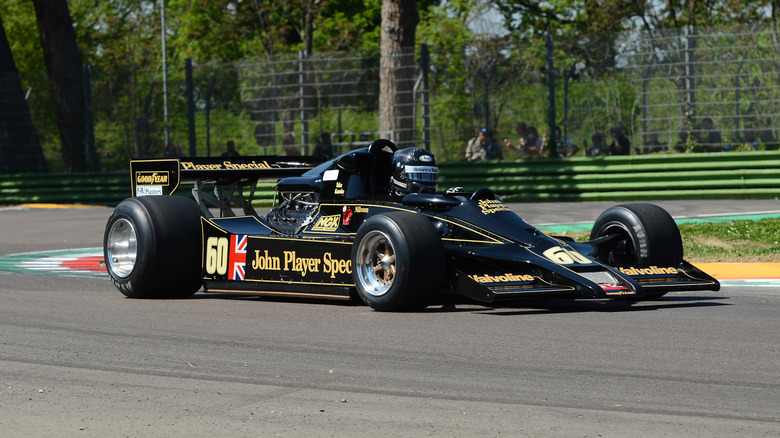The Reason Why This Legendary Lotus Was Banned From F1
It could be said that if your Formula One car isn't banned, or at least investigated by the stewards, then you simply aren't trying hard enough. From active suspension and traction control, to cars with six wheels, two brake pedals, and giant fans spinning to create extra downforce — as seen on today's T.50 hypercar — Formula One cars have a history of bending the rules.
Some of the more sophisticated F1 technologies to be banned concern aerodynamics, the dark art that takes the physics used to get airplanes off the deck, turns it upside down, and uses it to keep race cars stuck to the road. That and ground effect, the phenomenon where low-pressure air is created beneath the floor of a car, sucking it into the track, increasing grip and lowering lap times, is what gave the Lotus Type 88 its edge.
First, a quick history lesson. The designers of mid-century race cars from focused on streamlining their vehicles, creating bodies with sleek and smooth panels that would minimize drag and increase speed. Next came a rudimentary understanding of downforce, where wings fixed to the bodywork pushed the car into the road. The third step was ground effect. Aerodynamicists of the 1970s turned their attention underneath the car to exploit an aerodynamic principle called the Venturi effect, where the entire chassis is designed to act like an inverted wing, creating low pressure beneath it and sucking the car to the ground.
Downforce contained by flexible skirts
British team Lotus and its founder Colin Chapman, famous for his "simplify, then add lightness" approach to race car design, were true innovators in the early days of Formula One, pioneering the monocoque chassis, aerofoil wings and ground effect.
The first Lotus car to feature ground effect was the Type 78 of 1977, and the technology was perfected for the subsequent Type 79, which won the 1978 Formula One World Championship. As well as a floor shaped like an inverted aerofoil, the Type 78 had flexible skirts that created a seal between the sides of the car and the race track, preventing air from escaping as it was fed rearwards, increasing downforce.
Lotus failed to repeat this success with the Type 80, and from 1981 the sliding skirts were banned by a new rule requiring 60mm (2.36 inch) of ground clearance, in a bid to slow cars down.
To get around these new rules, Lotus created the Type 88 that featured a unique double-chassis design. Lotus explains: "At the heart of its pioneering approach was the fact it has two chassis ... Chapman realized there was nothing in the rules to stop a car having two of them. The primary chassis was made from carbon fiber and Kevlar, and included the engine and the driver's cockpit. It was sprung separately, and more softly, to a second stiffer chassis which managed all the aerodynamic downforce."
Banned and never raced
The car complied with ground clearance rules when stationary. But once up to speed, downforce pushed on the sprung bodywork, reduced the 60 mm gap and created a seal for enhanced ground effect. "The Type 88 basically got around the rule that was trying to ban ground effect," said Clive Chapman, son of Colin.
Unfortunately, the sport's regulators quickly pointed to the rule book, which stated: "... aerodynamic parts must remain immobile in relation to the sprung part of the car". The Type 88 was disqualified during practice for the first round of the 1981 season, held at the United States Grand Prix West at Long Beach, and again at the next round in Brazil. The same happened with a third race in Argentina. Chapman then boycotted the fourth round at Imola in San Marino.
A revised car, called the Type 88B, was entered for the British Grand Prix, but that was also banned before it had a chance to race, and for the rest of the season Lotus switched back to the single-chassis Type 87. The Type 88 was retired, never to compete in Formula One.
Despite being a non-starter, the Type 88 is also significant for being the first Formula One car to feature a carbon chassis. This accolade is often given to the McLaren MP4/1, but that car didn't appear until the third round of the 1981 championship, making it instead the first carbon chassis to race, since the Lotus was outlawed before it had the chance to compete.


